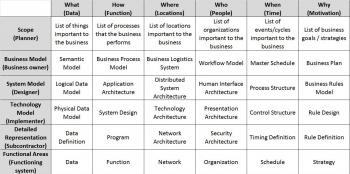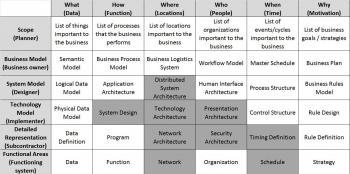The Zachman framework
In 1987, John Zachman created a model to help documenting enterprise architectures. The Zachman model is a classic under the architecture models, and one of the first ones. A picture of the model is shown below.
Figure: Zachman framework
The model has six basic questions (columns) which must be answered by each of six viewpoints (rows) in order to describe an architecture. The basic questions are: What, How, Where, Who, When, and Why, and the viewpoints are:
- Scope (as seen from a planner)
- Business model (as seen from a business owner)
- System model (as seen from a designer)
- Technology model (as seen from an implementer)
- Detailed Representation (as seen from a subcontractor)
- Functional areas (as seen from the functioning system)
This leads to a matrix with 36 cells. When the cells are filled an overview of the complete enterprise architecture is created. In the cells the document is stated. For instance, the “What” of a Technology model (as seen from the implementer of the system) is a document describing the physical data model.
The big advantage of the model is that it is well known by most architects. It creates a common vocabulary amongst architects and it organizes architecture descriptions quite well.
A drawback of the model is that it can lead to creating a large number op documents, when everything is described in full detail. Furthermore, the model is primarily meant for architects; it is not very suited for end users, developers, or management. It is basically a framework for architects only.
Infrastructure architects could use the Zachman framework to create documents to describe the infrastructure. The relevant fields for infrastructure architecture are grayed in the picture below.
Figure: Relevant fields for infrastructure architecture
Zachman describes no method for filling in the framework. TOGAF has an Architecture Development Method (ADM) that can be used for this.
The Zachman model was created when John Zachman worked for IBM (he is retired now), and IBM has put the framework in the public domain. Therefore no license is needed for using the Zachman framework.
26 Jan 2015 Added: Here is an interesting interview with John Zachman about the origins of his model.
This entry was posted on Friday 24 May 2013
 Dutch
Dutch
